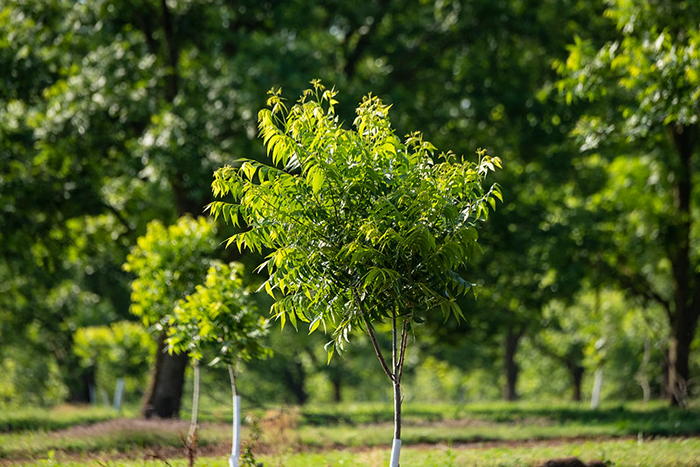They don’t.
But they have evolved a reasonable way to avoid it all the same. It is a bit of a coincidence.
According to researchers at the University of Georgia, the Pecan budbreak is based on an interesting combination of Winter Chill Hours and Spring Heat Units – also known as hours below 39F between Nov 1 and March 1 and hours above 65F between March 1 and April 25, respectively.

And in order to hit the right balance of the two, it takes time. How much? Enough time that it doesn’t happen until later in the Spring when most of the frosting is done.
I say most, because a few late season frosts have caught many folks, and I suppose the Pecan trees, by surprise over the years.
The Math
Despite what is often cited casually, “Longer, colder winters mean the plants take longer to wake up” isn’t necessarily true for the Pecan. Or a handful of other plants, too. The more Chill Hours during the Winter may actually wake the tree up sooner! Or vice-versa. And whatever the balance is, for each Pecan tree, between the Chill Hours and the Heat Units is the thing that wakes up those Pecan trees to budbreak.
How much of each of the Chill Hours and Heat Units is needed? Again, according to the researchers at the University of Georgia, Between 200 and 500 Chill Hours, and then more than 300 Heat Units.


A longer,colder Winter means more Chill Hours and, thus, the Spring doesn’t have to be as warm to get budbreak. And if the Winter is mild then it can take longer in Spring to build up enough Heat Units to get the tree moving again.
But check out this cool bit of coincidence….
Long cold winter? If it happens, it tends to happen during a La Nina. Those years we also tend to – historically – warm up quicker in Spring. Buds out early! Long mild Winter? Usually an El Nino. Those years we tend to warm up slower. Buds out later.
Tricky little trees!
How did we do in 2023 up until ?
From Nov 1 through Jan 31 we have accumulated about 275-300 Chill Hours across the area. So we have clipped the necessary threshold. But, since the quickness of the budbreak is relative to how many Chill Hours are accumulated, the more Chill Hours, the fewer Heat Units needed.
So during the final month of the Chill Hours period, we need to hope to pick up as many Chill Hours as possible if we want Pecans to budbreak earlier. Or, conversely, if we are okay with Pecans just hanging around, dormant, for a bit longer, we can say Phooey! to Chill Hours and hope for warmth.
The Forecast
Or, we could simply look at the forecast for 2023.
At the time of this article, the GFS computer weather model (the image below on the left,big thanks to Storm Vista for the graphic) the general trend across the south during the next two weeks will be above normal temperatures. And according to the CPC, the image below on the right, the entire month of February ahs a better chance of being warmer, not colder, than normal.

That doesn’t mean there will be zero Chill Hours, but it does mean that the likelihood of the normal number of Chill Hours is lower than normal.
The normal low temperature for the rest of the month? Warmer than 39F.
So, a brief recap here: Forecast is warmer than normal and normal for a low is already warmer than 39F.
So any cool down that we see to shove temperatures below 39F will likely be brief. Meaning the number of Chill Hours will stay close to where they are right now as we close out February.
That also means that we will need more Heat Units to wake up the Pecan trees.
The Bottom Line
A lot of folks like to wait for Pecan trees to budbreak before they put seeds in the ground. Or they wait until after Easter. Because, by then, folks have told me, the chance for a frost or freeze is lower.
That’s fine. If you want to continue to run with that, hey, it works!
But I would argue that research shows the trees are basing their budbreak on an unforecastable specific combo of Chill Hours and Heat Units between two sets of dates. And those things have very little bearing on the forecast moving forward, aside form a broad generalization based on climatology.
As for waiting until after Easter, that is fine, too. But given that Easter bounces around through the calendar, there isn’t a way to know if one Easter in March is equally as safe to an Easter in April. So again, we would probably lean on climatology.
And the only reason “it works” is because generally the last freeze is around March 15th. The last frost is generally about a week later. That is Climatology.
But the potential for a late season frost or freeze has very little to do with trees, holidays, the calendar, or even, some years, Climatology! It has more to do with the week-to-week, and sometimes day-to-day, weather patterns that develop.

